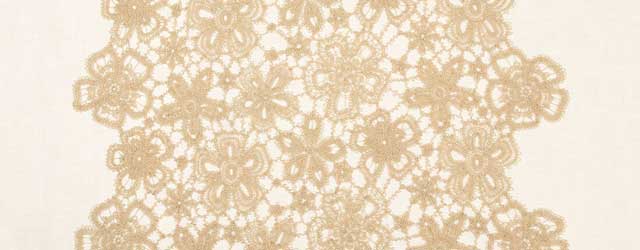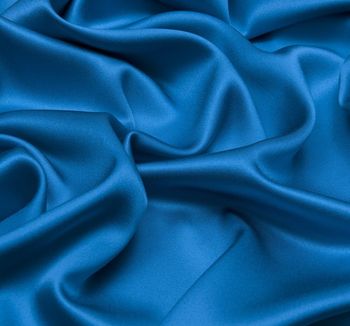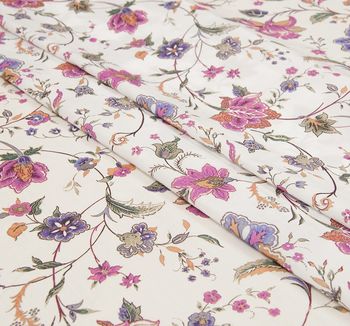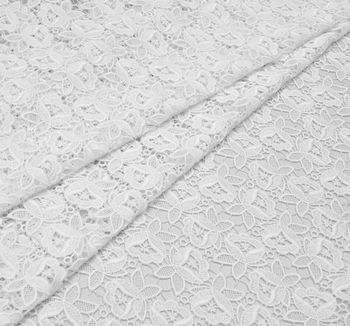Silk is a timelessly trendy natural fabric woven from the cocoons of silk worms. The world’s most famous fashion brands regularly apply it for various men’s and women’s outfits earning the admiration of the audience.
Guipure Lace
Guipure lace fabric is a delicate type of lace created of convex lace elements which are connected with bars or plaits, resulting in an airy ornament. Its structure makes it one of the most elegant options for cocktail, evening and bridal dresses, blouses or accessories.
Guipure appeared in Italy at the end of the 16 th century and was created of finest cellulose or silk threads. In Milan and Flanders, the technique “point de rose” was applied. Point de rose is about ethereal floral pattern, which elements are interconnected with small picot loops.
In fashion context, guipure is widely perceived as a regal fabric imbuing women’s textured outfits with a particular grace.
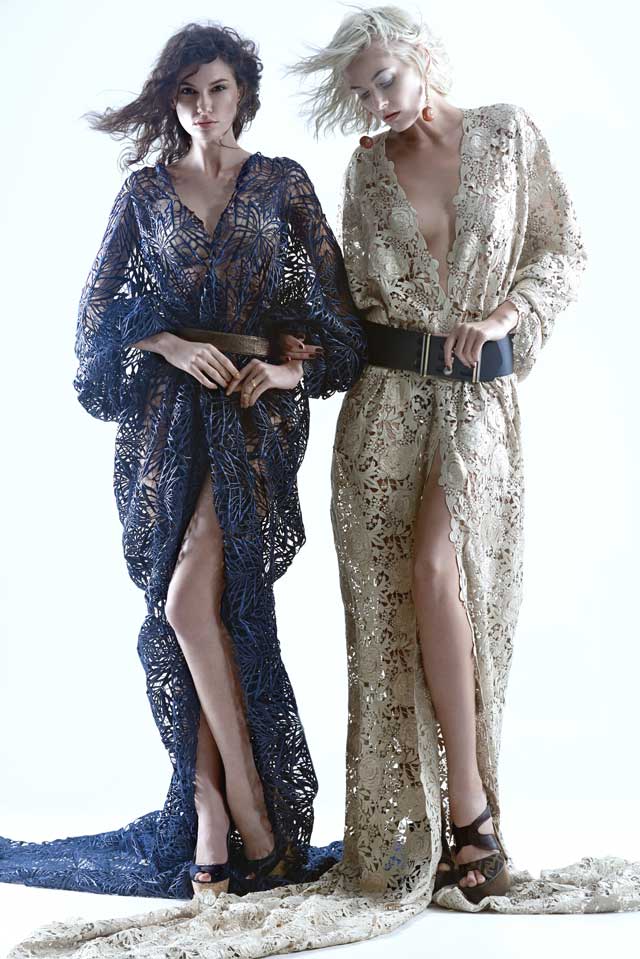
Production and Properties
Guipure lace is produced both by traditional and modern methods:
- Pulling out — a pattern is applied onto fabric and the extra fibres are literally pulled out of it. To eliminate friability and generally make the fabric more durable, the pattern gets enforced by weaving it with additional threads.
- Etching — the embroidery is performed on a soluble fabric, which afterwards gets dissolved in a special solution.
- By spinning machines — a pattern is set with the help of the program. This production method includes both natural fabrics (stiff and densely woven lace with a pronounced pattern) and synthetic ones (providing a particularly fine fabric).
Guipure can be woven of various threads:
- Silk — a natural fibre obtained by unwinding the cocoons of a silkworm;
- Cotton — an organic fibre of cotton fluff;
- Flax — an organic natural fibre of a flax plant;
- Viscose — an artificial fibre based on wood pulp;
- Lurex — a synthetic fibre that is metallized or covered with foil to give shine;
- Lycra — a synthetic stretch fibre;
- Polyester — a synthetic fibre made from thermoplastic polymers.
Most often, the main ornament is made with natural threads, and the connecting grid includes synthetics. However, this rule is optional and the detailed composition is typically indicated by the manufacturer on the label of the product.
Types
Based on the fibre type, the following categories of guipure lace are distinguished:
- classic guipure — an openwork fabric without additives;
- leather-guipure — a dense and durable fabric;
- stretch-guipure — a stretching elastic fabric with the addition of Lycra;
- metallic — a dense opaque fabric with metallic lustre;
- grid — a thin cloth with a small percentage of embroidery;
- guipure with lurex — an elegant fabric with glitter;
- knitted guipure — an elastic, stretching material.
This fabric may feature various colours and be either yarn-dyed or printed. It can also be embellished with beads or sequins, especially in case of bridal guipure lace.
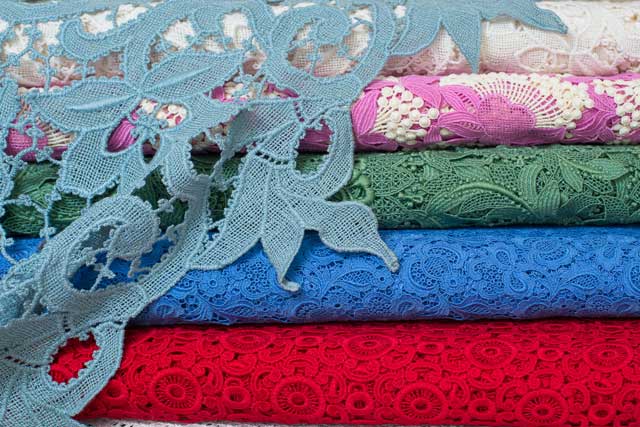
Properties
Guipure lace can be rightfully called one of the most elegant lace fabrics ever created. However, as you might have noticed earlier, in most cases, guipure performs as a decorative material combined with other fabrics. Why? To give you a hint, pay attention to the guipure weave structure. Its elements often feature a complex shape that requires a thoughtful approach in the planning of their interconnection with bars or plaits: the fabric should remain elegant, yet not lose much in durability.
However, the compromise between durability and design cannot guarantee you protection against occasional tearing or tightening. That is one of the reasons for why these fabrics are typically combined with solid textiles like satin, chiffon, crepe, chintz, etc. in the ground. There’s also another reason, which is about the way guipure lace feels — its net-like structure may cause your skin some discomfort.
Nevertheless, guipure lace boasts lots of pros, which you can compare with a few cons in the table 1 below:
|
pro |
contra |
|---|---|
|
Elegant Shape-retaining Transparent Lightweight Easy to care for |
Can be quite stiff Subjective to tearing and tightening Complex in dyeing |
Application
Such elegant fabric as guipure lace is applied in lots of areas. Festive dresses, office blouses, lingerie — these are only a small part of guipure lace uses:
- Cocktail, evening and bridal dresses,
- Blouses and skirts,
- Mittens,
- Scarves and shawls,
- Сurtains, lambrequins,
- Wristbands, collars,
- Linings,
- Pillow décor.
What makes guipure particularly great is that it doesn’t require any extra décor, as it is decorative itself. The fabric is often combined with metallic accessories and rhinestones.
-(compressed).jpg)
Tissura Collection
Why should you buy guipure lace fabrics online at Tissura? Our collection has always comprised the most delicate guipure fabrics of the kind, by such renowned brands as Sophie Hallette, Solstiss Sa and HOH. The true fabric connoisseurs will particularly admire our exclusive guipure lace selection that literally takes your breath away: the plethora of intricate details, golden metallic fibres, multicoloured colourways and such exotic and desirable motifs as ostrich feathers, gossamer, or the romantic combination of stars and flowers. These chef-d’oeuvre designs are created by the brands which names speak volumes to anyone in the world of haute couture: Swiss Forster Rohner AG and Jakob Schlaepfer, Austrian HOH, French Solstiss Sa, and Italian Aldo Bianchi.
.jpg)
What makes a guipure lace collection at Tissura especially exciting is that we update our range as soon as the manufacturers develop a new design, sometimes even before its official release!
To get a clue for what kind of guipure lace we have, check out this selection:
Guipure lace fabric, 242 US$ (199 €) per one running metre;
Red guipure lace fabric, 289 US$ (238 €) per one running metre;
Black guipure lace fabric, 209 US$ (172 €) per one running metre;
Beige guipure lace fabric, 172 US$ (141 €) per one running metre.
How to stay cool on a hot summer day? Wear fabrics built for the heat. Cotton, linen, viscose, silk – there are dozens of summer-friendly materials you can choose for your wardrobe. The best fabric to opt for when the temperature rises should be breathable and comfortable.
The wedding dress is one of the most important clothing items a woman gets to choose in her lifetime. It can be made of silk or cotton, lace or tulle, be strewn with sequins or embroidered with beads.
.jpg)
.jpg)
.jpg)
